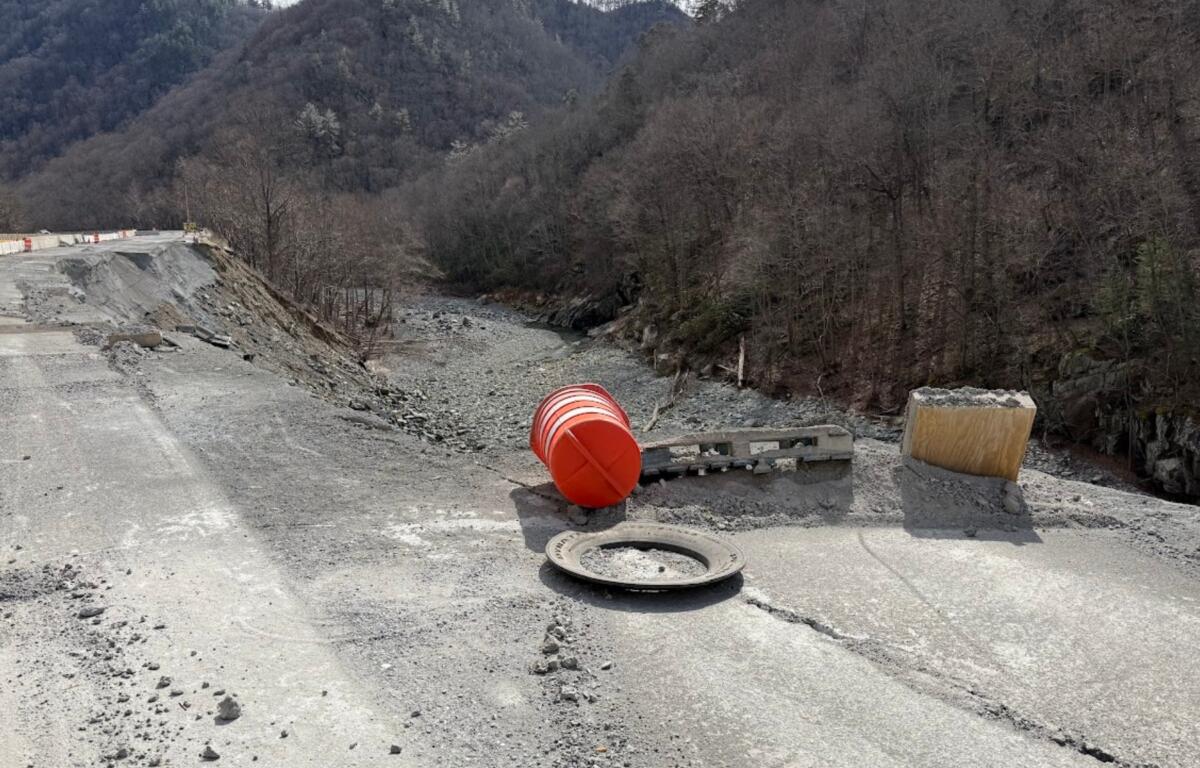HAYWOOD COUNTY, N.C. (828newsNOW) — The stretch of Interstate 40 in the Pigeon River Gorge near the North Carolina/Tennessee line is set to reopen — one lane in each direction — on Saturday.
That’s the good news. The bad news is traffic delays could be significant, North Carolina Department of Transportation officials warned during a news event Thursday.
The eastbound lanes were severely damaged during Tropical Storm Helene, NCDOT Communications Officer David Uchiyama said.
“So traffic will be traveling on the westbound side in a one-lane pattern in each direction. So, one lane westbound, one lane eastbound. That will be separated by a 9-inch by 9-inch concrete curb that is anchored into the asphalt. The travel lanes are severely reduced and the speed limit has been reduced to 35 mph,” he said while standing in one of the damaged eastbound lanes. “I want to highlight the fact that this is an active zone.”
NCDOT and contract crews have stabilized the westbound lanes and prepared them to provide one lane of traffic in each direction, NCDOT Assistant Engineer Nathan Tanner said.
Combined with the restoration efforts in Tennessee, the one-lane stretch extends approximately 12 miles from Cold Springs Creek Road (Exit 7) in North Carolina to Big Creek Road (Exit 447) in Tennessee.
On the North Carolina side, drivers heading through the Pigeon River Gorge corridor should expect unusual conditions for interstate travel:
- Narrowed lanes with reduced shoulders
- A reduced speed limit of 35 mph
- A 9-inch by 9-inch concrete curb separating traffic
- Periodic breaks to provide EMS access
- Emergency-only lane on the eastbound side
- Standard 18-wheelers allowed; no wide loads
- Anticipate delays
Tanner said the work that has been done so far is part of a $12-$15 million emergency contract to stabilize the road and reopen part of it.
He said Wright Brothers Construction and its partners GeoStabilization International have been working on soil nail installation.
“It’s a temporary shoring mechanism that uses steel rods drilled into the mountainside to hold everything in place so that we don’t lose any more of the open travel lanes,” Tanner said.
“That work will be completed this week. It has been completed. That’s why we’re moving forward with the March 1 opening.”
Trucks with oversize loads will not be allowed to use that section of the highway, but 18-wheelers or tractor trailers will.
Wide loads must utilize I-77 and I-81 to travel between the two states.
Drivers of standard 18-wheelers should note that while they will be allowed to travel on I-40 through the gorge, there are no alternate routes available for them beyond Exit 20 (U.S. 276) despite some GPS devices and mobile phone apps suggesting they can take an exit in the gorge.
Other drivers should consider the alternate route of I-26 from Asheville to Kingsport, Tenn., then I-81 South to I-40.
Tanner said officials expect it to be two to three years of construction time for permanent repairs to the gorge area.
“But in that time frame, we’re going to be working towards opening up to more lanes to travel as early as possible,” Tanner said.
He said NCDOT is about 10 to 12 percent into a plan for a design for permanent repairs. There is no estimate for what the final repair costs will be.
Tanner said opening I-40, even in a limited fashion, will help local and state economies.
“Billions of dollars a day of goods are being transported along this route,” he said.
What crews have done in the five months since Helene sent the Pigeon River roaring through the gorge and over the road has been “monumental,” Tanner said.
“It’s a big deal. It’s a big accomplishment. On average, on a normal construction project when you’re doing soil nail installation in like conditions, the soil nail contractors achieve around 1,000 square feet a day. We were averaging 3,000 to 4,000 square feet a day,” Tanner said. “So it’s a monumental accomplishment on a historic project that North Carolina has never seen the like of.”
Tanner said the two lanes through the gorge would reopen some time Saturday, but he did not have an exact time.
“Our engineers have prioritized this project and this opening over everything else from the top down. And we’re going to be working every day to get it repaired. Every day it gets a little better,” Tanner said.













